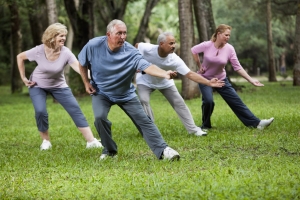Will Exercise Help Prevent Parkinson’s Disease?

Julia Basso, PhD
Affiliation: New York University, Center for Neural Science
Parkinson’s disease is a neurodegenerative disorder characterized by loss of dopamine neurons in the substantia nigra pars compacta, a part of the brain’s basal ganglia system. The symptoms of this disease are motoric in nature and include tremor, or a shaking of the extremities; rigidity or stiffness of the body; bradykinesia or slow movements; and instability in posture, balance and coordination. Later symptoms include cognitive impairments similar to dementia as well as neuropsychiatric issues such as depression.
Parkinson’s Affects Who and How
This disease primarily effects individuals over 60 years of age, is 1.5 times more prevalent in males than females, and is present in approximately 1 million Americans (www.pdf.org). The basal ganglia are a series of interconnected regions located in the center of the brain that are involved in both motor and motivational behaviors. This system connects to the cerebral cortex, which then sends information to the brain stem and spinal cord to coordinate our physical actions.
Healthy individuals’ dopamine, the neurotransmitter made by neurons in the substantia nigra, helps to regulate the system, creating smooth, synchronous movements. With Parkinson’s disease, as more and more of the dopamine neurons die, motor movement becomes progressively impaired and symptoms worsen. Levodopa, which is a precursor to dopamine and is able to cross the blood brain barrier, is often given as a therapeutic agent to help increase dopamine levels in the brain and remediate Parkinson’s symptoms.
Dopamine Levels
In healthy rodents, long-term voluntary wheel running increases dopamine levels in the striatum (Meeusen & De Meirleir, 1995), a part of the basal ganglia circuitry that is impaired in Parkinson’s disease. As a result, this finding led scientists to investigate the effects of exercise in animal models of Parkinson’s disease. Studies have utilized an animal model known as the MPTP (1-methyl-4-phenyl-1,2,3,6-tetrahydropyridine) model (Fisher et al., 2004; Petzinger et al., 2007). MPTP is a neurotoxin that kills dopamine neurons and causes motor impairments similar to Parkinson’s disease. Rodents were administered either saline (control group) or MPTP and exposed to either one month of treadmill running or a sedentary experience. MPTP lesioning significantly shortened treadmill running time and decreased treadmill running speed.
Motor Behaviors and Exercise
By the end of the exercise experience, however, MPTP mice significantly improved their running abilities. They ran just as long and as fast as controls. Another way to examine motor behavior is to use the rotarod test (think Wipeout, the gameshow). In this test, a mouse has to balance on a continuously rotating rod. Furthermore, MPTP mice who exercised performed significantly better on this test than those without exercise. This shows that exercise in this disease model improves several aspects of motor behavior (bradykinesia and coordination).
Additionally, MPTP mice who exercised, compared to their non-exercising counterparts, showed a significant decrease in the number of dopamine transporters in the striatum. When dopamine is released from one neuron, it enters a small space between two cells called the synapse. As a result, dopamine either binds to a nearby cell via a dopamine receptor or is taken back up (i.e., recycled) by the same cell via a dopamine transporter. If there are fewer dopamine transporters, more dopamine will be available to bind to and act on adjoining cells. Therefore, exercise in this animal model of Parkinson’s disease produced a more active dopamine system (Petzinger et al., 2015).
Protective Effects On The Brain
Lifetime exercise in humans has proven to have protective effects on the brain, especially in terms of neurodegenerative disorders like Parkinson’s disease (Reynolds et al., 2016). Additionally, exercise interventions have been shown to improve Parkinson’s symptoms including motor, mood and cognitive impairments. These findings may be due to improvements in the dopamine system as exercise increases dopamine levels in the human brain (Wang et al., 2000).
Looking to Research
One recent and exciting study examined the effects of exercise on the brains of Parkinson’s patients in the early stage of the disease (within 1 year of diagnosis) (Fisher et al., 2013). For two months, four individuals were randomly assigned to either remain sedentary or run on a treadmill three times per week for 45 minutes at 75% of their age-predicted maximum heart rate. Before and after this two-month period, dopamine activity was measured in their brains using positron emission tomography. Then, oOver the two-month period, the Parkinson’s patients who exercised showed a significant improvement in their ability to turn. Additionally, these individuals demonstrated a significant enhancement in dopamine activity in the striatum (average of 90% increase), whereas sedentary individuals showed a decrease (average of 13% loss).
Collectively, this research shows that exercise in Parkinson’s patients maybe able to help alleviate symptoms. This could happen by causing neurotransmitter changes in the basal ganglia, a series of brain regions involved in the pathophysiology of the disease. Depending on the stage of the disease, patients with Parkinson’s disease may find it extremely difficult to exercise, especially at high intensities.
 Takeaways
Takeaways
Therefore, I encourage Parkinson’s patients and their families to talk with physical therapists and other movement specialists to see what they recommend in terms of exercise regimens. Exercises such as walking, stretching and toning, yoga, tai chi, and dance are just some examples that may be appropriate. As such, just remember that physical activities can always be moderated and even performed in such settings as a bed or chair. Finally, the end goal is to remain physically active to encourage positive changes in the brain.
References:
Fisher, B. E., Li, Q., Nacca, A., Salem, G. J., Song, J., Yip, J., … & Petzinger, G. M. (2013). Treadmill exercise elevates striatal dopamine D2 receptor binding potential in patients with early Parkinson’s disease.Neuroreport, 24(10), 509-514.
Fisher, B. E., Petzinger, G. M., Nixon, K., Hogg, E., Bremmer, S., Meshul, C. K., & Jakowec, M. W. (2004). Exercise‐induced behavioral recovery and neuroplasticity in the 1‐methyl‐4‐phenyl‐1, 2, 3, 6‐tetrahydropyridine‐lesioned mouse basal ganglia. Journal of neuroscience research, 77(3), 378-390.
Meeusen, R., & De Meirleir, K. (1995). Exercise and brain neurotransmission. Sports Medicine, 20(3), 160-188.
Petzinger, G. M., Holschneider, D. P., Fisher, B. E., McEwen, S., Kintz, N., Halliday, M., … & Jakowec, M. W. (2015). The Effects of Exercise on Dopamine Neurotransmission in Parkinson’s Disease: Targeting Neuroplasticity to Modulate Basal Ganglia Circuitry. Brain plasticity, 1(1), 29-39.
Petzinger, G. M., Walsh, J. P., Akopian, G., Hogg, E., Abernathy, A., Arevalo, P., … & Jakowec, M. W. (2007). Effects of treadmill exercise on dopaminergic transmission in the 1-methyl-4-phenyl-1, 2, 3, 6-tetrahydropyridine-lesioned mouse model of basal ganglia injury. The Journal of neuroscience, 27(20), 5291-5300.
Reynolds, G. O., Otto, M. W., Ellis, T. D., & Cronin‐Golomb, A. (2015). The Therapeutic Potential of Exercise to Improve Mood, Cognition, and Sleep in Parkinson’s Disease. Movement Disorders.
Wang, G. J., Volkow, N. D., Fowler, J. S., Franceschi, D., Logan, J., Pappas, N. R., … & Netusil, N. (2000). PET studies of the effects of aerobic exercise on human striatal dopamine release. Journal of Nuclear Medicine,41(8), 1352-1356.
(adsbygoogle = window.adsbygoogle || []).push({});
You Might Like:
The Science of Temperature Therapy
Temperature therapy (also known as “thermal therapy” or “thermotherapy”) involves the use of heat or cold to improve health and function. Interestingly, thermotherapy has been around for centuries, with ancient cultures regularly using hot springs,...The Predictors of Longevity You Need to Care About
Living a long and healthy life is a universal aspiration, and with the publication of Peter Aittia’s new book “Outlive”, it has never been a bigger focus. With this has come the realisation that, while...How Overtraining and Undertraining Impacts Hormonal Health
While maintaining a healthy hormonal balance is essential for overall health and wellbeing, it is an often-overlooked component of women’s health. Hormones play a vital role in regulating various bodily functions, including metabolism, energy, mood,...12 days of Fitness: 12 Holiday workouts to crush this Christmas
The holiday period is a time for friends, food, and family. With this in mind, it should be a time of guilt-free fun. However, that doesn’t mean you have to neglect your fitness entirely over...Upper Body Strength in Post-Menopausal Women
Menopause is a unique time in the human life, and with it comes a myriad of changes that can have wide reaching health implications. However, over the last 20 years we have seen a strong...Exercise After Menopause: What You Need To Know
Menopause is one of the most significant events in a woman’s life, and with it comes several changes that can affect function. Moreover, the post-menopausal period comes with many health considerations that can have a...(adsbygoogle = window.adsbygoogle || []).push({});














